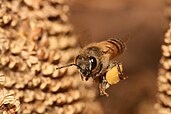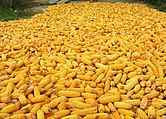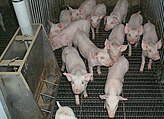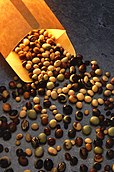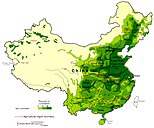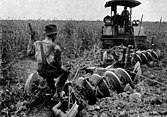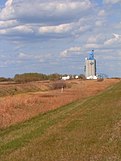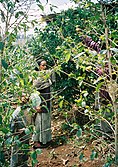Purge server cache
Selected article 1
Portal:Agriculture/Selected article/1
Butter is a dairy product made from the fat and protein components of churned cream. It is a semi-solid emulsion at room temperature, consisting of approximately 80% butterfat. It is used at room temperature as a spread, melted as a condiment, and used as a fat in baking, sauce-making, pan frying, and other cooking procedures.Most frequently made from cow's milk, butter can also be manufactured from the milk of other mammals, including sheep, goats, buffalo, and yaks. It is made by churning milk or cream to separate the fat globules from the buttermilk. Salt has been added to butter since antiquity to help preserve it, particularly when being transported; salt may still play a preservation role but is less important today as the entire supply chain is usually refrigerated. In modern times, salt may be added for taste. Food coloring is sometimes added to butter. Rendering butter, removing the water and milk solids, produces clarified butter, or ghee, which is almost entirely butterfat.
Butter is a water-in-oil emulsion resulting from an inversion of the cream, where the milk proteins are the emulsifiers. Butter remains a firm solid when refrigerated but softens to a spreadable consistency at room temperature and melts to a thin liquid consistency at 32 to 35 °C (90 to 95 °F). The density of butter is 911 g/L (15+1⁄4 oz/US pt). It generally has a pale yellow color but varies from deep yellow to nearly white. Its natural, unmodified color is dependent on the source animal's feed and genetics, but the commercial manufacturing process sometimes alters this with food colorings like annatto or carotene. (Full article...) (Full article...)
Selected article 2
Portal:Agriculture/Selected article/2
A honey bee (also spelled honeybee) is a eusocial flying insect within the genus Apis of the bee clade, all native to mainland Afro-Eurasia. After bees spread naturally throughout Africa and Eurasia, humans became responsible for the current cosmopolitan distribution of honey bees, introducing multiple subspecies into South America (early 16th century), North America (early 17th century), and Australia (early 19th century).Honey bees are known for their construction of perennial colonial nests from wax, the large size of their colonies, and surplus production and storage of honey, distinguishing their hives as a prized foraging target of many animals, including honey badgers, bears and human hunter-gatherers. Only 8 surviving species of honey bee are recognized, with a total of 43 subspecies, though historically 7 to 11 species are recognized. Honey bees represent only a small fraction of the roughly 20,000 known species of bees. (Full article...) (Full article...)
Selected article 3
Portal:Agriculture/Selected article/3
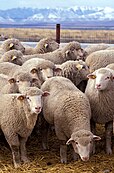
Sheep are most likely descended from the wild mouflon of Europe and Asia. One of the earliest animals to be domesticated for agricultural purposes, sheep are raised for fleece, meat (lamb, hogget or mutton) and milk. A sheep's wool is the most widely used animal fiber, and is usually harvested by shearing. Ovine meat is called lamb when from younger animals and mutton when from older ones. Sheep continue to be important for wool and meat today, and are also occasionally raised for pelts, as dairy animals, or as model organisms for science.
Sheep farming is practised throughout the majority of the inhabited world, and has been fundamental to many civilizations. In the modern era, Australia, New Zealand, the southern and central South American nations, and the British Isles are most closely associated with sheep production. (Full article...)
Selected article 4
Portal:Agriculture/Selected article/4
Rice is the seed of the monocot plants Oryza sativa or Oryza glaberrima. As a cereal grain, it is the most important staple food for a large part of the world's human population, especially in East and South Asia, the Middle East, Latin America, and the West Indies. It is the grain with the second-highest worldwide production, after maize (corn).Since a large portion of maize crops are grown for purposes other than human consumption, rice is the most important grain with regard to human nutrition and caloric intake, providing more than one fifth of the calories consumed worldwide by the human species.
Rice is normally grown as an annual plant, although in tropical areas it can survive as a perennial and can produce a ratoon crop for up to 30 years. The rice plant can grow to 1–1.8 m (3.3–5.9 ft) tall, occasionally more depending on the variety and soil fertility. It has long, slender leaves 50–100 cm (20–39 in) long and 2–2.5 cm (0.79–0.98 in) broad. The small wind-pollinated flowers are produced in a branched arching to pendulous inflorescence 30–50 cm (12–20 in) long. The edible seed is a grain (caryopsis) 5–12 mm (0.20–0.47 in) long and 2–3 mm (0.079–0.118 in) thick. (Full article...)
Selected article 5
Portal:Agriculture/Selected article/5
Fish farming is the principal form of aquaculture, while other methods may fall under mariculture. Fish farming involves raising fish commercially in tanks or enclosures, usually for food. A facility that releases young (juvenile) fish into the wild for recreational fishing or to supplement a species' natural numbers is generally referred to as a fish hatchery. The most common fish species raised by fish farms are salmon, carp, tilapia, European seabass, catfish and cod.There is an increasing demand for fish and fish protein, which has resulted in widespread overfishing in wild fisheries. Fish farming offers fish marketers another source. However, farming carnivorous fish, such as salmon, does not always reduce pressure on wild fisheries, since carnivorous farmed fish are usually fed fishmeal and fish oil extracted from wild forage fish. In this way, the salmon can consume in weight more wild fish than they weigh themselves. The global returns for fish farming recorded by the FAO in 2008 totalled 33.8 million tonnes worth about $US 60 billion. (Full article...)
Selected article 6
Portal:Agriculture/Selected article/6
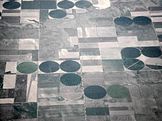
A business producing tree fruits or nuts is called an orchard; a vineyard produces grapes. The stable is used for operations principally involved in the training of horses. Stud and commercial farms breed and produce other animals and livestock. A farm that is primarily used for the production of milk and dairy is a dairy farm. A market garden or truck farm is a farm that grows vegetables, but little or no grain. Additional specialty farms include fish farms, which raise fish in captivity as a food source, and tree farms, which grow trees for sale for transplant, lumber, or decorative use. A plantation is usually a large farm or estate, on which cotton, tobacco, coffee or sugar cane, are cultivated, often by resident laborers. (Full article...)
Selected article 7
Portal:Agriculture/Selected article/7
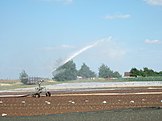
There are several methods of irrigation that differ in how water is supplied to plants. Surface irrigation, also known as gravity irrigation, is the oldest form of irrigation and has been in use for thousands of years. In sprinkler irrigation, water is piped to one or more central locations within the field and distributed by overhead high-pressure water devices. Micro-irrigation is a system that distributes water under low pressure through a piped network and applies it as a small discharge to each plant. Micro-irrigation uses less pressure and water flow than sprinkler irrigation. Drip irrigation delivers water directly to the root zone of plants. Subirrigation has been used in field crops in areas with high water tables for many years. It involves artificially raising the water table to moisten the soil below the root zone of plants. (Full article...) (Full article...)
Selected article 8
Portal:Agriculture/Selected article/8
Wheat (Triticum spp.) is a grass, originally from the Fertile Crescent region of the Near East, but now cultivated worldwide. In 2007 world production of wheat was 607 million tons, making it the third most-produced cereal after maize (784 million tons) and rice (651 million tons).Globally, wheat is the leading source of vegetable protein in human food, having a higher protein content than either maize (corn) or rice, the other major cereals. In terms of total production tonnages used for food, it is currently second to rice as the main human food crop, and ahead of maize, after allowing for maize's more extensive use in animal feeds.
Wheat normally needs between 110 and 130 days between planting and harvest, depending upon climate, seed type, and soil conditions (winter wheat lies dormant during a winter freeze). Optimal crop management requires that the farmer have a detailed understanding of each stage of development in the growing plants. In particular, spring fertilizers, herbicides, fungicides, growth regulators are typically applied only at specific stages of plant development. Several systems exist to identify crop stages, with the Feekes and Zadoks scales being the most widely used. Each scale is a standard system which describes successive stages reached by the crop during the agricultural season. (Full article...)
Selected article 9
Portal:Agriculture/Selected article/9
"Bean" is a common name for large plant seeds of several genera of the family "fabaceae" (alternately "leguminosae") used for human food or animal feed.The whole young pods of bean plants, if picked before the pods ripen and dry, are very tender and may be eaten cooked or raw. Thus the term "green beans" means "green" in the sense of unripe (many are in fact not green in color). In some cases, the beans inside the pods of "green beans" are too small to comprise a significant part of the cooked fruit. Beans have significant amounts of fiber and soluble fiber, with one cup of cooked beans providing between nine and 13 grams of fiber. Soluble fiber can help lower blood cholesterol. Beans are also high in protein, complex carbohydrates, folate, and iron.
Beans are one of the longest-cultivated plants. Broad beans, with seeds the size of the small fingernail, were gathered in their wild state in Afghanistan and the Himalayan foothills. In a form improved from naturally occurring types, they were grown in Thailand already since the early seventh millennium (BC), predating ceramics. They were deposited with the dead in ancient Egypt. Not until the second millennium BC did cultivated, large-seeded broad beans appear in the Aegean, Iberia and transalpine Europe. In the "Iliad" (late-8th century) is a passing mention of beans and chickpeas cast on the threshing floor. The oldest-known domesticated beans in the Americas were found in Guitarrero Cave, an archaeological site in Peru, and dated to around the second millennium BCE. (Full article...)
Selected article 10
Portal:Agriculture/Selected article/10
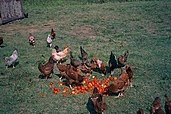
More than 50 billion chickens are raised annually as a source of food, for both their meat and their eggs. Chickens raised for meat are called broilers, while those raised for eggs are called laying hens. In total, the UK alone consumes over 29 million eggs per day. Some hens can produce over 300 eggs a year. Chickens will naturally live for 6 or more years. After 12 months, the hen’s productivity will start to decline. This is when most commercial laying hens are slaughtered.
The majority of poultry are raised using intensive farming techniques. According to the Worldwatch Institute, 74 percent of the world's poultry meat, and 68 percent of eggs are produced this way. One alternative to intensive poultry farming is free range farming.
Friction between these two main methods has led to long term issues of ethical consumerism. Opponents of intensive farming argue that it harms the environment and creates health risks, as well as abusing the animals themselves. Advocates of intensive farming say that their highly efficient systems save land and food resources due to increased productivity, stating that the animals are looked after in state-of-the-art environmentally controlled facilities. A few countries have banned cage system housing, including Sweden and Switzerland, yet consumers can still purchase lower cost eggs from other countries' intensive poultry farms. (Full article...)
Selected article 11
Portal:Agriculture/Selected article/11
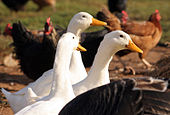
Poultry is the second most widely eaten meat in the world, accounting for about 30% of meat production worldwide, after pork at 38%.
Chicken meat contains about two to three times as much polyunsaturated fat than most types of red meat when measured as weight percentage. (Full article...)
Selected article 12
Portal:Agriculture/Selected article/12
Maize (corn) is a grain and the most widely grown crop in the Americas with 332 million metric tons grown annually in the United States. Approximately 40% of the crop - 130 million tons - is used for corn ethanol. Transgenic maize (Genetically Modified Corn) made up 85% of the maize planted in the United States in 2009. While some maize varieties grow to 12 metres (39 ft) tall, most commercially grown maize has been bred for a standardized height of 2.5 metres (8.2 ft).Maize is widely cultivated throughout the world, and a greater weight of maize is produced each year than any other grain. The United States produces 40% of the world's harvest; other top producing countries include China, Brazil, Mexico, Indonesia, India, France and Argentina. Worldwide production was 817 million tonnes in 2009—more than rice (678 million tonnes) or wheat (682 million tonnes). In 2009, over 159 million hectares of maize were planted worldwide, with a yield of over 5 tonnes/hectare. Production can be significantly higher in certain regions of the world; 2009 forecasts for production in Iowa were 11614 kg/ha.
Maize was domesticated by indigenous peoples in Mesoamerica in prehistoric times. The leafy stalk produces ears which contain seeds called kernels. Though technically a grain, maize kernels are used in cooking as a vegetable or starch. The Olmec and Mayans cultivated it in numerous varieties throughout central and southern Mexico, cooked, ground or processed through nixtamalization. Between 1700 and 1250 BCE, the crop spread through much of the Americas. The region developed a trade network based on surplus and varieties of maize crops. After European contact with the Americas in the late 15th and early 16th centuries, explorers and traders carried maize back to Europe and introduced it to other countries. Maize spread to the rest of the world due to its ability to grow in diverse climates. Sugar-rich varieties called sweet corn are usually grown for human consumption, and are usually shorter in length than field corn varieties, which are used for animal feed and as chemical feedstocks. (Full article...)
Selected article 13
Portal:Agriculture/Selected article/13
Aquaculture, also known as aquafarming, is the farming of aquatic organisms such as fish, crustaceans, molluscs and aquatic plants. Aquaculture involves cultivating freshwater and saltwater populations under controlled conditions, and can be contrasted with commercial fishing, which is the harvesting of wild fish. Mariculture refers to aquaculture practised in marine environments.The reported output from global aquaculture operations would supply one half of the fish and shellfish that is directly consumed by humans, however there are issues about the reliability of the reported figures. Further, in current aquaculture practice, products from several pounds of wild fish are used to produce one pound of a piscivorous fish like salmon.
Particular kinds of aquaculture include fish farming, shrimp farming, oyster farming, algaculture (such as seaweed farming), and the cultivation of ornamental fish. Particular methods include aquaponics, which integrates fish farming and plant farming. (Full article...)
Selected article 14
Portal:Agriculture/Selected article/14
Pig farming, pork farming, or hog farming is the raising and breeding of domestic pigs as livestock, and is a branch of animal husbandry. Pigs are farmed principally for food (e.g. pork: bacon, ham, gammon) and skins.Pigs are amenable to many different styles of farming: intensive commercial units, commercial free range enterprises, or extensive farming (being allowed to wander around a village, town or city, or tethered in a simple shelter or kept in a pen outside the owner's house). Historically, farm pigs were kept in small numbers and were closely associated with the residence of the owner, or in the same village or town. They were valued as a source of meat and fat, and for their ability to convert inedible food into meat and manure, and were often fed household food waste when kept on a homestead. Pigs have been farmed to dispose of municipal garbage on a large scale.
All these forms of pig farm are in use today, though intensive farms are by far the most popular, due to their potential to raise a large amount of pigs in a very cost-efficient manner. In developed nations, commercial farms house thousands of pigs in climate-controlled buildings. Pigs are a popular form of livestock, with more than one billion pigs butchered each year worldwide, 100 million in the United States. The majority of pigs are used for human food, but also supply skin, fat and other materials for use in clothing, ingredients for processed foods, cosmetics, and medical use. (Full article...) (Full article...)
Selected article 15
Portal:Agriculture/Selected article/15 Cattle (colloquially cows) are the most common type of large domesticated ungulates. They are a prominent modern member of the subfamily Bovinae, are the most widespread species of the genus Bos, and are most commonly classified collectively as Bos primigenius. Cattle are raised as livestock for meat (beef and veal), as dairy animals for milk and other dairy products, and as draft animals (oxen / bullocks) (pulling carts, plows and the like). Other products include leather and dung for manure or fuel. In some countries, such as India, cattle are sacred. It is estimated that there are 1.3 billion cattle in the world today. In 2009, cattle became the first livestock animal to have its genome mapped.
Cattle are farmed for beef, veal, dairy, leather and they are less commonly used for conservation grazing, simply to maintain grassland for wildlife – for example, in Epping Forest, England. They are often used in some of the most wild places for livestock. Depending on the breed, cattle can survive on hill grazing, heaths, marshes, moors and semi-desert. Modern cows are more commercial than older breeds and, having become more specialized, are less versatile. For this reason many smaller farmers still favor old breeds, like the dairy breed of cattle Jersey. (Full article...)
Selected article 16
Portal:Agriculture/Selected article/16
The soybean (U.S.) or soya bean (UK) (Glycine max) is a species of legume native to East Asia, widely grown for its edible bean which has numerous uses. The plant is classed as an oilseed rather than a pulse by the Food and Agricultural Organisation (FAO).Fat-free (defatted) soybean meal is a primary, low-cost source of protein for animal feeds and most prepackaged meals; soy vegetable oil is another product of processing the soybean crop. For example, soybean products such as textured vegetable protein (TVP) are ingredients in many meat and dairy analogues. Soybeans produce significantly more protein per acre than most other uses of land.
Traditional nonfermented food uses of soybeans include soy milk, and from the latter tofu and tofu skin. Fermented foods include soy sauce, fermented bean paste, natto, and tempeh, among others. The oil is used in many industrial applications. The main producers of soy are the United States (35%), Brazil (27%), Argentina (19%), China (6%) and India (4%). The beans contain significant amounts of phytic acid, alpha-linolenic acid, and the isoflavones genistein and daidzein.
Soy varies in growth and habit. The height of the plant varies from below 20 cm (7.9 in) up to 2 metres (6.6 ft). The pods, stems, and leaves are covered with fine brown or gray hairs. The leaves are trifoliolate, having three to four leaflets per leaf, and the leaflets are 6–15 cm (2.4–5.9 in) long and 2–7 cm (0.79–2.76 in) broad. The leaves fall before the seeds are mature. The inconspicuous, self-fertile flowers are borne in the axil of the leaf and are white, pink or purple. The fruit is a hairy pod that grows in clusters of three to five, each pod is 3–8 cm long (1–3 in) and usually contains two to four (rarely more) seeds 5–11 mm in diameter. (Full article...)
Selected article 17
Portal:Agriculture/Selected article/17

Selected article 18
Portal:Agriculture/Selected article/18
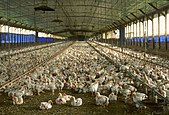
Confinement at high stocking density is one part of a systematic effort to produce the highest output at the lowest cost by relying on economies of scale, modern machinery, biotechnology, and global trade. Confinement at high stocking density requires antibiotics and pesticides to mitigate the spread of disease and pestilence exacerbated by these crowded living conditions. In addition, antibiotics are used to stimulate livestock growth by killing intestinal bacteria. There are differences in the way factory farming techniques are practiced around the world. There is a continuing debate over the benefits and risks of factory farming. The issues include the efficiency of food production; animal welfare; whether it is essential for feeding the growing global human population; the environmental impact and the health risks.
The large concentration of animals, animal waste, and the potential for dead animals in a small space poses ethical issues. It is recognized that some techniques used to sustain intensive agriculture can be cruel to animals. As awareness of the problems of intensive techniques has grown, there have been some efforts by governments and industry to remove inappropriate techniques. (Full article...)
Selected article 19
Portal:Agriculture/Selected article/19
A shrimp farm is an aquaculture business for the cultivation of marine shrimp or prawns[1] for human consumption. Commercial shrimp farming began in the 1970s, and production grew steeply, particularly to match the market demands of the United States, Japan and Western Europe. The total global production of farmed shrimp reached more than 1.6 million tonnes in 2003, representing a value of nearly 9 billion U.S. dollars. About 75% of farmed shrimp is produced in Asia, in particular in China and Thailand. The other 25% is produced mainly in Latin America, where Brazil, Ecuador, and Mexico are the largest producers. The largest exporting nation is Thailand.Shrimp farming has changed from traditional, small-scale businesses in Southeast Asia into a global industry. Technological advances have led to growing shrimp at ever higher densities, and broodstock is shipped worldwide. Virtually all farmed shrimp are of the family Penaeidae, and just two species – Penaeus vannamei (Pacific white shrimp) and Penaeus monodon (giant tiger prawn) – account for roughly 80% of all farmed shrimp. These industrial monocultures are very susceptible to diseases, which have caused several regional wipe-outs of farm shrimp populations. Increasing ecological problems, repeated disease outbreaks, and pressure and criticism from both NGOs and consumer countries led to changes in the industry in the late 1990s and generally stronger regulation by governments. In 1999, a program aimed at developing and promoting more sustainable farming practices was initiated, including governmental bodies, industry representatives, and environmental organizations. (Full article...)
Selected article 20
Portal:Agriculture/Selected article/20
Agriculture in Burma (officially Myanmar) is the main industry in the country with 6,300,000 hectares as of 2003. The most important crop is rice, and Burma was once Asia's largest exporter of rice, but as of 2003 had fallen to just 7th. Other main crops are pulses, cereals, sesame, groundnuts, sugarcane, hardwood, fish, beans, butter beans, kidney beans, black eye beans, bamboo beans, red beans, mung beans, kenaf and peas. Cotton is also an important industry.Under British administration, Burma was the world largest exporter of rice. Burmese crops helped to alleviate severe famines in India. Farmers use a slash and burn method to take down trees and make room for their crops. But they grow rice in open well irrigated fields. Agriculture in Burma provides 43% of Burma's GDP and requires 70% of Burma's workforce. This means that agriculture is the most important work in Burma. (Full article...)
Selected article 21
Portal:Agriculture/Selected article/21
The domestic pig (also swine, in some areas hog) is a domesticated animal that traces its ancestry to the wild boar, and is considered a subspecies of the wild boar or a distinct species in its own right. It is likely the wild boar was domesticated as early as 13,000 BC in the Tigris River basin. Pigs are farmed for the consumption of their flesh, but some cultures have religious dietary laws that forbid the consumption of pig meat. The animal's bones, hide, and bristles have been fashioned into items for human use such as brushes, and pigs have been kept as pets, especially the pot bellied pig. Miss Piggy, Babe, and Porky the Pig represent the domestic pig in entertainment and "The Three Little Pigs", Charlotte's Web, and The Sheep-Pig are prominent examples of the domestic pig in literature.Most domestic pigs have rather sparse hair covering on their skin, although woolly coated breeds, such as the Mangalitsa, are raised. Archaeological evidence suggests that pigs were domesticated from wild boar as early as 13,000–12,700 BC in the Near East in the Tigris Basin being managed in the wild in a way similar to the way they are managed by some modern New Guineans. Remains of pigs have been dated to earlier than 11,400 BC in Cyprus that must have been introduced from the mainland which suggests domestication in the adjacent mainland by then. There was also a separate domestication in China. (Full article...)
Selected article 22
Portal:Agriculture/Selected article/22
The domestic turkey is a large poultry bird. The modern domesticated form descends from the wild turkey (Meleagris gallopavo), one of the two species of turkey (genus Meleagris); in the past the ocellated turkey (Meleagris ocellata) was also domesticated.The turkey is raised throughout temperate parts of the world and is a popular form of poultry, partially because industrialized farming has made it very cheap for the amount of meat it produces. The female domesticated turkey is referred to as a hen and the chick as a poult. In the United States, the male is referred to as a tom, while in Europe, the male is a stag. The average lifespan for a domesticated turkey is ten years.
The great majority of domesticated turkeys are bred to have white feathers because their pin feathers are less visible when the carcass is dressed, although brown or bronze-feathered varieties are also raised. The fleshy protuberance atop the beak is the snood and the one attached to the underside of the beak is known as a wattle.
Despite the name, turkeys have no direct relation to the country of Turkey and are native to North America; see further under Turkey (bird): History and naming. (Full article...)
Selected article 23
Portal:Agriculture/Selected article/23
Agriculture is an important economic sector of China, employing over 300 million farmers. China ranks first in worldwide farm output, primarily producing rice, wheat, potatoes, sorghum, peanuts, tea, millet, barley, cotton, oilseed, pork, and fish. Following the Communist Party of China's victory in the Chinese Civil War, control of the farmlands was taken away from landlords and redistributed to the 300 million peasant farmers. In 1952, gradually consolidating its power following the civil war, the government began organizing the peasants into teams. Three years later, these teams were combined into producer cooperatives, enacting the Socialist goal of collective land ownership. In the following year, 1956, the government formally took control of the land, further structuring the farmland into large government-operated collective farms.As China continues to industrialize, vast swaths of agricultural land is being converted into industrial land. Farmers displaced by such urban expansion often become migrant labor for factories, but other farmers feel disenfranchised and cheated by the encroachment of industry and the growing disparity between urban and rural wealth and income.
The most recent innovation in Chinese agriculture is a push into organic agriculture. This rapid embrace of organic farming simultaneously serves multiple purposes, including food safety, health benefits, export opportunities, and by providing price premiums for the produce of rural communities, the adoption of organics can help stem the migration of rural workers to the cities. In the mid 1990s China became a net importer of grain, since its unsustainable practices of groundwater mining has effectively removed considerable land from productive agricultural use. (Full article...)
Selected article 24
Portal:Agriculture/Selected article/24
Agriculture is a major industry in the United States of America and the country is a net exporter of food. As of the last census of agriculture in 2007, there were 2.2 million farms, covering an area of 922 million acres (3,730,000 km2), an average of 418 acres (1.69 km2) per farm. Agriculture in the United States is primarily governed by periodically renewed U.S. farm bills. Governance is both a federal and a local responsibility with the United States Department of Agriculture being the federal department responsible. Government aid includes research into crop types and regional suitability as well as many kinds of subsidies, some price supports and loan programs. American farmers are not subject to production quotas and some laws are different for farms compared to other workplaces. A large part of the American farm workforce is made up of migrant and seasonal workers, many of them recent immigrants from Latin America or aliens working under work permits. Additional laws apply to these workers and their housing which is often provided by the farmer.Corn, turkeys, tomatoes, potatoes, peanuts, and sunflower seeds constitute some of the major holdovers from the agricultural endowment of the Americas. European agricultural practices greatly affected the New England landscape, leaving behind many physical foot prints. Colonists brought livestock over from Europe which caused many changes to the land. Grazing animals required a lot of land and food to sustain them and due to grazing, native grasses were destroyed and European species began to replace them. New species of weeds were introduced and began to thrive as they were capable of withstanding the grazing of animals, whereas native species could not. In 2004, of the 145 million employed workers in the US, 834,000 of them held jobs as agricultural workers. 83% of these jobs were as farm workers. The median hourly income as of May 2004[update] was $7.70 for farmworkers planting, growing and harvesting crops, and $8.31 for farmworkers tending to animals. (Full article...)
Selected article 25
Portal:Agriculture/Selected article/25
An estimated 10-15% of argentinian farmland is foreign owned.
In 2007, more than one fifth of Argentine exports of about US$56 billion were composed of unprocessed agricultural primary goods, mainly soybeans, wheat and maize. A further one third were composed of processed agricultural products, such as animal feed, flour and vegetable oils. The national governmental organization in charge of overseeing agriculture is the Secretariat of Agriculture, Cattle Farming, Fishing and Food (Secretaría de Agricultura, Ganadería, Pesca y Alimentos, SAGPyA).
Argentine beef and other meats are some of the most important agricultural export products of Argentina. Nearly 5 million tonnes of meats (not including seafood) are produced in Argentina, long the world's leading beef consumer on a per capita basis. Beef accounts for 3.2 million tonnes (not counting 500.000 tonnes of edible offal). Then, following in importance: chicken, with 1.2 million tonnes; pork, with 265,000 and mutton (including goat meat), over 100,000. Cattle is mainly raised in the provinces of Buenos Aires and Santa Fe. Additional significant agricultural commodities include cereals, oilseeds, fruit, vegetables, sugar cane, dairy products and fish/seafood. (Full article...)
Selected article 26
Portal:Agriculture/Selected article/26
Agriculture in the Soviet Union was organized into a system of state and collective farms, known as sovkhozes and kolkhozes, respectively. Following a grain crisis in 1928, Joseph Stalin established the USSR's system of state and collective farms when he moved to replace the NEP with collective farming, which grouped peasants into collective farms (kolkhozes) and state farms (sovkhozes). Organized on a large scale and relatively highly mechanized, the Soviet Union was one of the world's leading producers of cereals, although bad harvests (as in 1972 and 1975) necessitated imports and slowed the economy. The 1976-1980 five-year plan shifted resources to agriculture, and 1978 saw a record harvest. Cotton, sugar beets, potatoes, and flax were also major crops.However, despite immense land resources, extensive machinery and chemical industries, and a large rural work force, Soviet agriculture was relatively unproductive, hampered in many areas by the climate (only 10 percent of the Soviet Union's land was arable), and poor worker productivity. Conditions were best in the temperate black earth belt stretching from Ukraine through southern Russia into the west, spanning the extreme southern portions of Siberia.
Stalin's campaign of forced collectivization was a major factor explaining the sector's poor performance. Collectivization relied on a system of internal passports to keep farmers tied to the land. This has been referred to as a form of "neo-serfdom", in which the Communist bureaucracy replaced the former landowners. The first response of most farmers to this loss of freedom was to slaughter and consume their farm animals. In the new state and collective farms, outside directives failed to take local growing conditions into account. Also, interference in the day-to-day affairs of peasant life often bred resentment and worker alienation across the countryside. The human toll was very large with millions, perhaps as many as 3 million, dying from famine in the wake of collectivisation. In the collective and state farms, low labor productivity was a consequence for the entire Soviet period.
The claims of inefficiency have, however, been criticized by Economist Joseph E. Medley of the University of Southern Maine, US. Statistics based on value rather than volume of production may give one view of reality, as public-sector food was heavily subsidized and sold at much lower prices than private-sector produce. In addition, the 2–3% of arable land allotted as private plots does not include the large area allocated to the peasants as pasturage for their private livestock; combined with land used to produce grain for fodder, the pasturage and the private plots total almost 20% of all Soviet farmland. Private farming may also be relatively inefficient, taking roughly 40% of all agricultural labor to produce only 26% of all output by value. Another problem is these criticisms tend to discuss only a small number of consumer products and do not take into account the fact that the kolkhozy and sovkhozy produced mainly grain, cotton, flax, forage, seed, and other non-consumer goods with a relatively low value per unit area. This economist admits to some inefficiency in Soviet agriculture, but claims that the failure reported by most Western experts would only be a myth. (Full article...)
Selected article 27
Portal:Agriculture/Selected article/27
Canada is one of the largest agricultural producers and exporters in the world. As with other developed nations, the proportion of the population and GDP devoted to agriculture fell dramatically over the 20th century but it remains an important element of the Canadian economy.A wide range of agriculture is practiced in Canada, from sprawling wheat fields of the prairies to summer produce of the Okanagan valley. In the federal government, overview of Canadian agriculture is the responsibility of the department of Agriculture and Agri-Food.
Agriculture in Canada comprises five main agricultural production sectors of commodity production resulting in farm cash receipts from both domestic and foreign markets.
Horticulture which includes garden crops, and fruits became easier to grow with the development of plant hardiness zones.
Apples, pears, plums and prunes, peaches, apricots, cherries, strawberries, raspberries, loganberries and fruit orchards are numerous and reach commercial size in the Annapolis Valley of Nova Scotia, New Brunswick, Quebec, Niagara Peninsula and Norfolk County of Ontario and Okanagan Valley of British Columbia.
Hazelnuts are harvested in Eastern Canada and British Columbia. Maple syrup and maple sugar, maple butter, and maple taffy are products of Quebec along the St. Lawrence River. The main market for Canadian maple syrup and sugar is the United States. Potatoes are an abundant harvest of the Maritime provinces. Sugar beets and beet root sugar are harvested in Quebec, Ontario, Manitoba, and Alberta.
115,000 cattle roamed the southern prairies by 1900. Livestock can include the raising of cows, also commonly called cattle. Recently domestication of the buffalo and elk has initiated a new food industry. Sheep have been raised for both wool and meat. Bovine or pig barns have been a part of livestock culture. Scientists have been making forward steps in swine research giving rise to intensive pig farming. The domestication of various farm animals meant that corresponding industries such as feedlots, animal husbandry and meat processing have also been studied, and developed. (Full article...)
Selected article 28
Portal:Agriculture/Selected article/28
A hardiness zone (a subcategory of Vertical Zonation) is a geographically defined area in which a specific category of plant life is capable of growing, as defined by climatic conditions, including its ability to withstand the minimum temperatures of the zone (see the scale on the right or the table below). For example, a plant that is described as "hardy to zone 10" means that the plant can withstand a minimum temperature of -1°C. A more resilient plant that is "hardy to zone 9" can tolerate a minimum temperature of -7°C. First developed for the United States by the Department of Agriculture (USDA), the use of the zones has been adopted by other nations.Based on the average annual minimum temperature for a given location, the USDA map provides an easy guideline for categorizing locations suitable for winter survival of a rated plant in an "average" winter. Since temperatures in the non-coastal-adjacent areas of the continent rarely present a consistent experience from year to year, and occasionally present a major—and often agriculturally devastating—deviation from the average minimum, the map has limitations for much of the country as a basis for using with long-term reliability, at least in areas close to the margin of a plant's rated hardiness-zone.
In 2003, the American Horticultural Society (AHS) produced a draft revised map, using temperature data collected from July 1986 to March 2002. This was a period of warmer winters than the 1974–1986 period, especially in the eastern U.S.A. The 2003 map placed many areas approximately a half-zone higher (warmer) than the 1990 map had. Reviewers noted the map zones appeared to be closer to the original 1960 map in its overall zone delineations. The 2003 AHS draft map purported to show finer detail, for example, reflecting urban heat islands by showing the downtown areas of several cities (e.g., Baltimore, Maryland, Washington, D.C. and Atlantic City, New Jersey) as a full zone warmer than outlying areas. The map excluded the detailed a/b half-zones introduced in the 1990 map, an omission widely criticized by horticulturists and gardeners due to the coarseness of the resulting map. The USDA rejected the AHS 2003 draft map; the agency stated it would create its own map in an interactive computer format. As of August 2010 the AHS and the National Arboretum websites still present the 1990 map as current. In 2006, the US National Arbor Day Foundation completed an extensive updating of U.S. Hardiness Zones. It used essentially the same data as the AHS. Once the Foundation analyzed the new data, it revised hardiness zones, reflecting the generally warmer recent temperatures in many parts of the country. The Foundation's 2006 map appears to validate the data used in the AHS 2003 draft. The Foundation also did away with the more detailed a/b half-zone delineations. (Full article...)
Selected article 29
Portal:Agriculture/Selected article/29
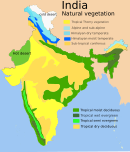
India is the largest producer in the world of fresh fruit, anise, fennel, badian, coriander, tropical fresh fruit, jute, pigeon peas, pulses, spices, millets, castor oil seed, sesame seeds, safflower seeds, lemons, limes, cow's milk, dry chillies and peppers, chick peas, cashew nuts, okra, ginger, turmeric guavas, mangoes, goat milk and buffalo milk and meat. India is also the largest producer of millets like Jowar Bajra and Ragi. It is second only to China in the production of rice. India is the 6th largest coffee producer in the world It also has the world's largest cattle population (281 million). It is the second largest producer of cashews, cabbages, cotton seed and lint, fresh vegetables, garlic, egg plant, goat meat, silk, nutmeg. mace, cardamom, onions, wheat, rice, sugarcane, lentil, dry beans, groundnut, tea, green peas, cauliflowers, potatoes, pumpkins, squashes, gourds and inland fish. It is the third largest producer of tobacco, sorghum, rapeseed, coconuts, hen's eggs and tomatoes. India accounts for 10% of the world fruit production with first rank in the production of mangoes, papaya, banana and sapota.
India's population is growing faster than its ability to produce rice and wheat.
Per the World Bank's "India Country Overview" in 2008:
(Full article...)"Slow agricultural growth is a concern for policymakers as some two-thirds of India’s people depend on rural employment for a living. Current agricultural practices are neither economically nor environmentally sustainable and India's yields for many agricultural commodities are low. Poorly maintained irrigation systems and almost universal lack of good extension services are among the factors responsible. Farmers' access to markets is hampered by poor roads, rudimentary market infrastructure, and excessive regulation."
— World Bank: "India Country Overview 2008"
Selected article 30
Portal:Agriculture/Selected article/30
Agriculture in Ethiopia is the foundation of the country's economy, accounting for half of gross domestic product (GDP), 83.9% of exports, and 80% of total employment.Ethiopia's agriculture is plagued by periodic drought, soil degradation caused by overgrazing, deforestation, high population density, high levels of taxation and poor infrastructure (making it difficult and expensive to get goods to market). Yet agriculture is the country's most promising resource. A potential exists for self-sufficiency in grains and for export development in livestock, grains, vegetables, and fruits. As many as 4.6 million people need food assistance annually.
Agriculture accounts for 46.3% of the GDP, 83.9% of exports, and 80% of the labour force. Many other economic activities depend on agriculture, including marketing, processing, and export of agricultural products. Production is overwhelmingly of a subsistence nature, and a large part of commodity exports are provided by the small agricultural cash-crop sector. Principal crops include coffee, pulses (e.g., beans), oilseeds, cereals, potatoes, sugarcane, and vegetables. Exports are almost entirely agricultural commodities, and coffee is the largest foreign exchange earner. Ethiopia is Africa's second biggest maize producer. Ethiopia's livestock population is believed to be the largest in Africa, and in 2006/2007 livestock accounted for 10.6% of Ethiopia's export income, with leather and leather products making up 7.5% and live animals 3.1%.
Ethiopi's major staple crops include a variety of cereals, pulses, oilseeds, and coffee. Grains are the most important field crops and the chief element in the diet of most Ethiopians. The principal grains are teff, wheat, barley, corn, sorghum, and millet. The first three are primarily cool-weather crops cultivated at altitudes generally above 1,500 meters. Teff, indigenous to Ethiopia, furnishes the flour for enjera, an sourdough pancakelike bread that is the principal form in which grain is consumed in the highlands and in urban centers throughout the country. Barley is grown mostly between 2,000 and 3,500 meters. A major subsistence crop, barley is used as food and in the production of tella, a locally produced beer.
Sorghum, millet, and corn are cultivated mostly in warmer areas at lower altitudes along the country's western, southwestern, and eastern peripheries. Sorghum and millet, which are drought resistant, grow well at low elevations where rainfall is less reliable. Corn is grown chiefly between elevations of 1,500 and 2,200 meters and requires large amounts of rainfall to ensure good harvests. These three grains constitute the staple foods of a good part of the population and are major items in the diet of the nomads.
Pulses are the second most important element in the national diet and a principal protein source. They are boiled, roasted, or included in a stew-like dish known as wot, which is sometimes a main dish and sometimes a supplementary food. Pulses, grown widely at all altitudes from sea level to about 3,000 meters, are more prevalent in the northern and central highlands. Pulses were a particularly important export item before the revolution. (Full article...)
Selected article 31
Portal:Agriculture/Selected article/31

Israel is home to two unique types of agricultural communities, the kibbutz and moshav, which developed as Jews from all over the world immigrated to the country and embarked on a pioneering enterprise.
The importance of agriculture in Israel's economy has fallen over time, accounting for decreasing values of GDP. In 1979, it accounted for just under 6% of GDP, in 1985 5.1%, and today, 2.5%. In 1995, there were 43,000 farm units with an average size of 13.5 hectares. 19.8% of these were smaller than 1 hectare, 75.7% were 1 to 9 hectares in size, 3.3% were between 10 and 49 hectares, 0.4% were between 50 and 190 hectares, and 0.8% were larger than 200 hectares. Of the 380,000 hectares under cultivation in 1995, 20.8% was under permanent cultivation and 79.2% under rotating cultivation. Farm units included 160,000 hectares used for activities other than cultivation. Cultivation was based mainly in the northern coastal plains, the hills of the interior, and the upper Jordan Valley. (Full article...)
Selected article 32
Portal:Agriculture/Selected article/32
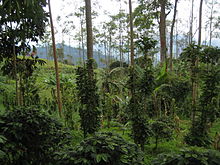
Sustainable agriculture is farming in sustainable ways meeting society's present food and textile needs, without compromising the ability for current or future generations to meet their needs. It can be based on an understanding of ecosystem services. There are many methods to increase the sustainability of agriculture. When developing agriculture within sustainable food systems, it is important to develop flexible business process and farming practices. Agriculture has an enormous environmental footprint, playing a significant role in causing climate change (food systems are responsible for one third of the anthropogenic greenhouse gas emissions), water scarcity, water pollution, land degradation, deforestation and other processes; it is simultaneously causing environmental changes and being impacted by these changes. Sustainable agriculture consists of environment friendly methods of farming that allow the production of crops or livestock without damage to human or natural systems. It involves preventing adverse effects to soil, water, biodiversity, surrounding or downstream resources—as well as to those working or living on the farm or in neighboring areas. Elements of sustainable agriculture can include permaculture, agroforestry, mixed farming, multiple cropping, and crop rotation.
Developing sustainable food systems contributes to the sustainability of the human population. For example, one of the best ways to mitigate climate change is to create sustainable food systems based on sustainable agriculture. Sustainable agriculture provides a potential solution to enable agricultural systems to feed a growing population within the changing environmental conditions. Besides sustainable farming practices, dietary shifts to sustainable diets are an intertwined way to substantially reduce environmental impacts. Numerous sustainability standards and certification systems exist, including organic certification, Rainforest Alliance, Fair Trade, UTZ Certified, GlobalGAP, Bird Friendly, and the Common Code for the Coffee Community (4C). (Full article...)
Selected article 33
Selected article 34
Selected article 35
Selected article 36
Selected article 37
Selected article 38
Selected article 39
Selected article 40
Selected article 41
Selected article 42
Selected article 43
Selected article 44
Selected article 45
Selected article 46
Selected article 47
Selected article 48
Selected article 49
Selected article 50
Purge server cache

